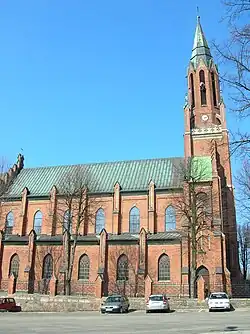Osjaków
Osjaków Ossyjakow, Osstenwerder | |
|---|---|
Village | |
| Osjaków | |
 Church | |
 Osjaków | |
| Coordinates: 51°17′18″N 18°47′33″E / 51.28833°N 18.79250°E | |
| Country | |
| Voivodeship | Łódź |
| County | Wieluń |
| Gmina | Osjaków |
| Population | 1,221 |
| Website | https://www.osjakow.pl/ |
Osjaków [ɔsˈjakuf] is a village in Wieluń County, Łódź Voivodeship, in central Poland. It is the seat of the gmina (administrative district) called Gmina Osjaków. It lies approximately 17 kilometres (11 mi) north-east of Wieluń and 73 km (45 mi) south-west of the regional capital Łódź.[1]
History
Myth
Osjaków's name has multiple theories for its origin. One of the most well-known involves a prince travelling through the area of what is now Osjaków. The prince supposedly decided to set up camp at the site of the modern-day town. He was stopped when a swarm of wasps attacked him and his servants. The prince began shouting the Polish word for wasps - osy (plural). Supposedly with time, this was altered to Osy-jakow and Osjakow.
The most likely origin for the name of the town comes from the Burgrave of Wieluń, Jan Ostrowski, who was the owner of Osjaków.
Early History - Middle Ages:[2]
The first mentions of Osjaków come from the 15th century. However, there are indications that it had city rights even before this time. The town's ideal location on the Warta river, meant it was able to rapidly develop. By 1499, it had 3 working water mills.
The name of the town fluctuated with its grammar during this period, with variants including: Osschyacow, de Ostrow, or Ossyakow.
18th - 19th Century:[3]
Until 1750, Osjaków was an average Polish provincial city. This was until the town was ravaged by a fire, which destroyed much of its wooden infrastructure. As a result, it lost its town rights in 1793. Until today Osjaków retains much of its city layout, with a central square.

During the Second Partitions of Poland, Osjakow was assimilated under the Kingdom of Prussia. During the period between 1807-1815, during the conflicts between France and Prussia. Osjakow briefly returned into Polish hands under the Duchy of Warsaw, by 1813 however, it was once again occupied by the Russian Empire. Throughout this period, the village remained near the border between the Prussian, and Russian Empires. [4]
20th Century
In 1909, the old wooden church of st Hedwig of Silesia was demolished to make place for the current church of Casimir the King. The church is now Osjakow's most recognizable monument.
World War 2:
Osjakow was located next to the first attacked city during World War 2 - Wieluń, which meant it was on the front lines of war. During the following days of war, Osjakow witnessed a mass influx of refugees from Wielun and other towns, who were fleeing to the east of the Warta. Despite not suffering much damage from a perspective of infrastructure. By October 8, 1939, Osjakow was assimilated into the Third Reich. Its name was Germanised into Ostenwerder. By 1941, the school, and church were closed, with the local priests having been sent to Dachau. The Prebystery was turned into the Gendarmerie base. In late 1944, much of Osjakow's population was rushed to help Nazi Germany in the Volkssturm.

Towards the end of war, during the Eastern Front (World War II), regions around Osjakow was the site of battles, as the Warta river was an important target. It then came under Soviet control much like the rest of Poland following the end of war.
Jewish history
Jews started settling into Osjakow in the early 18th century. Because the population was mostly working in trading, Jews mostly lived around the town square. This is why the old building of the synagogue is located in close proximity to the town square. The synagogue itself was built in the late 19th century. By 1897, 759 Jews lived in Osjakow, this was 49% of the village's total population.
During WW2, the Nazi occupation forced the Jews into the Osjakow Ghetto. In 1939, over 60% of Osjakow's population were Jews. In August 1942, the ghetto was liquidised. Most of the Jews were transported to the Łódź Ghetto (Litzmannstadt Ghetto).
Osjakow's Jewish cemetery was completely destroyed and forgotten after the war. However, the building of the old synagogue which was completely ravaged from inside still stands. It still retains a Torah ark on the entrance to the building.

References
- ↑ "Central Statistical Office (GUS) - TERYT (National Register of Territorial Land Apportionment Journal)" (in Polish). 2008-06-01.
- ↑ "Historia Osjakowa - Osjaków". www.osjakowianie.pl. Retrieved 2023-09-11.
- ↑ "Historia Osjakowa - Osjaków". www.osjakowianie.pl. Retrieved 2023-09-11.
- ↑ "Karta N-06118 - Galeria Fotografii Towarzystwa Opieki nad Zabytkami Przeszłości w zbiorach IS PAN". www.tonzp.dziedzictwowizualne.pl. Retrieved 2023-09-12.
External links
51°17′18″N 18°47′33″E / 51.28833°N 18.79250°E
